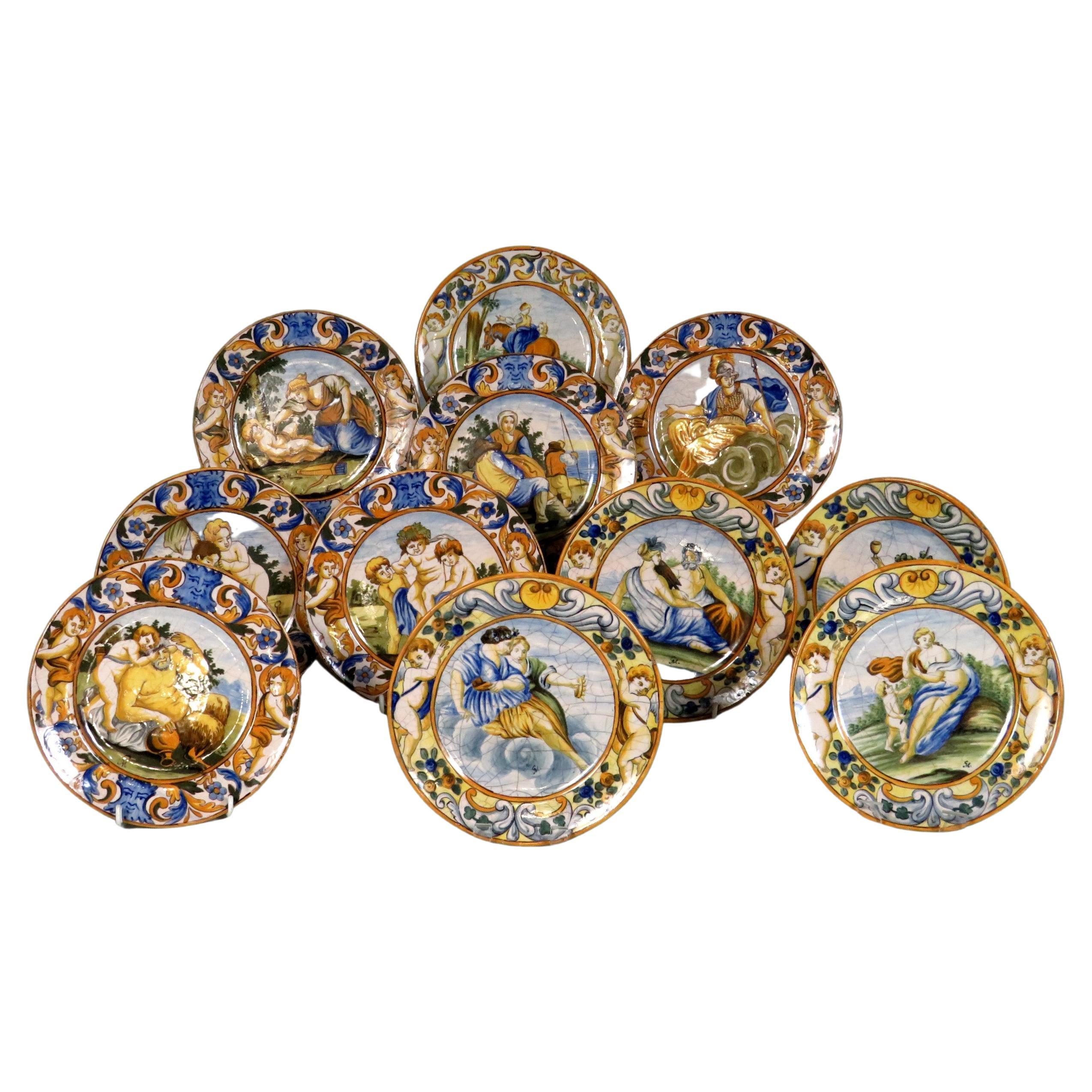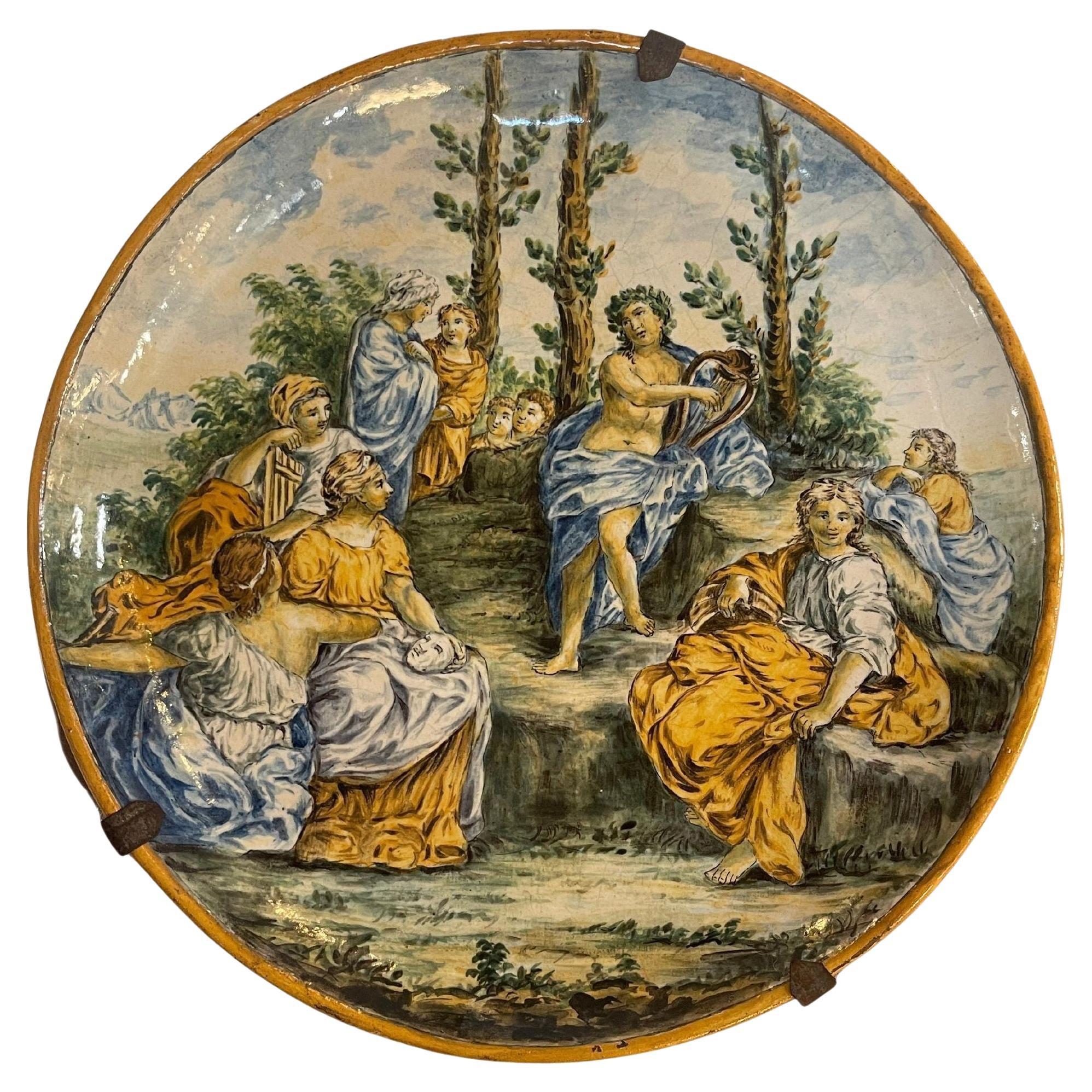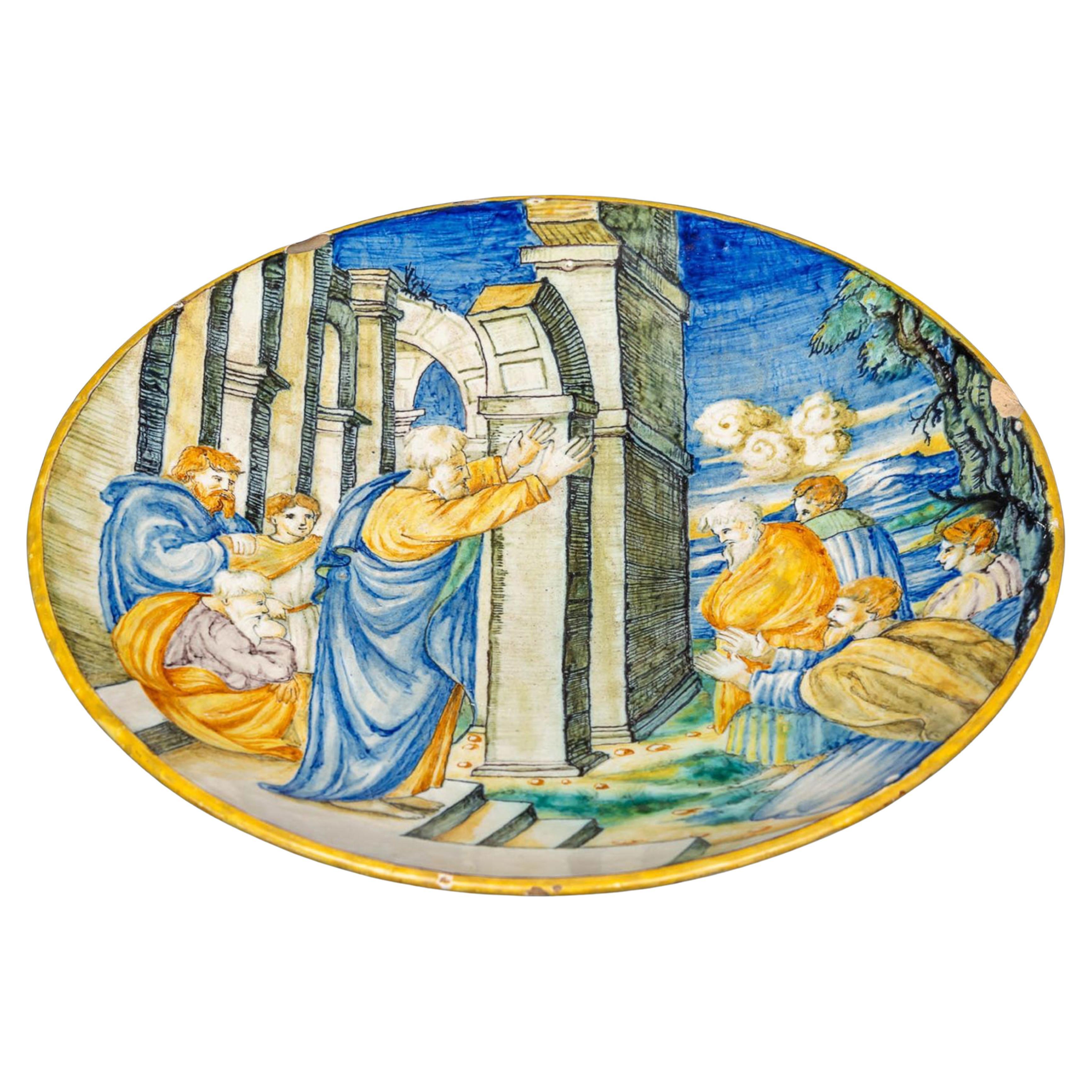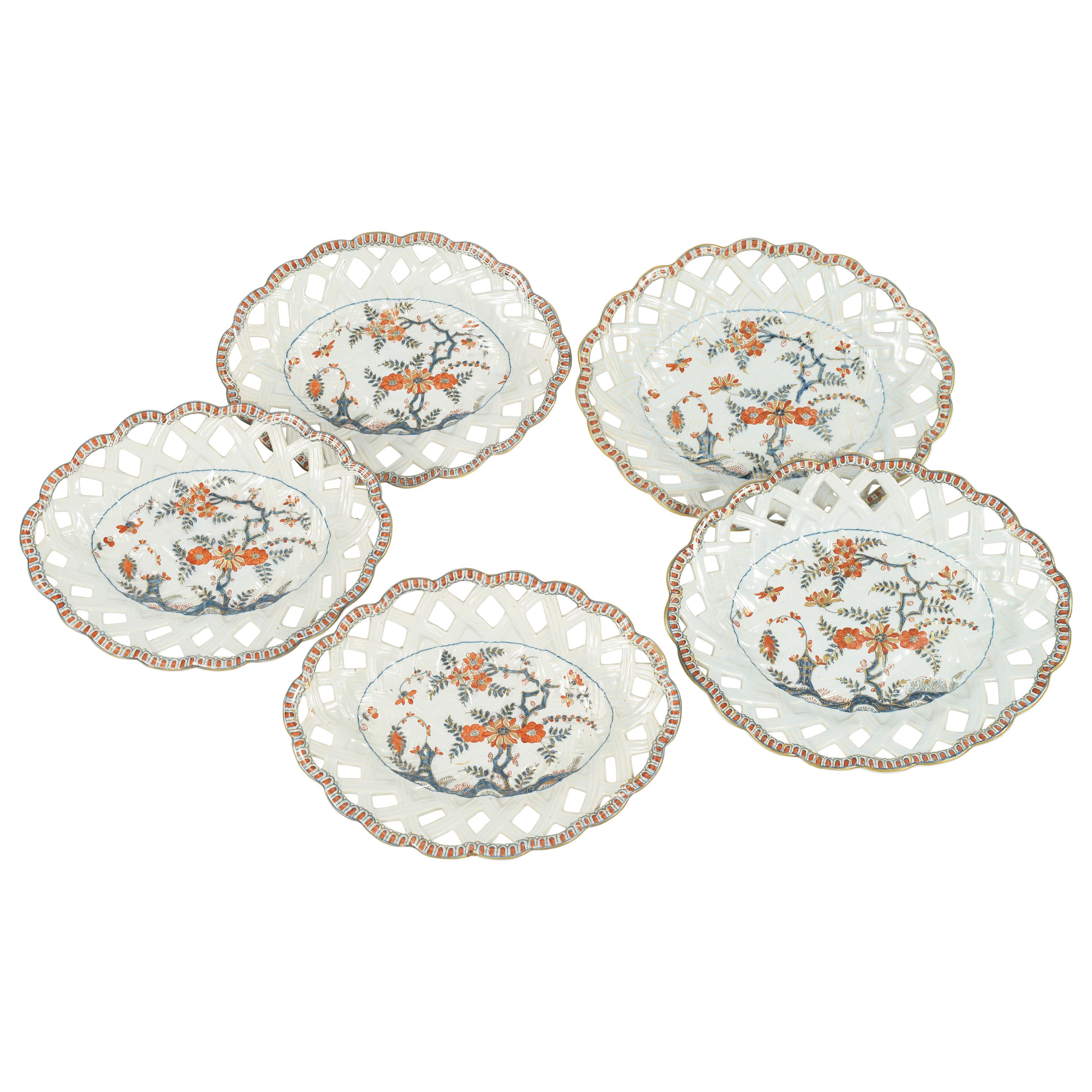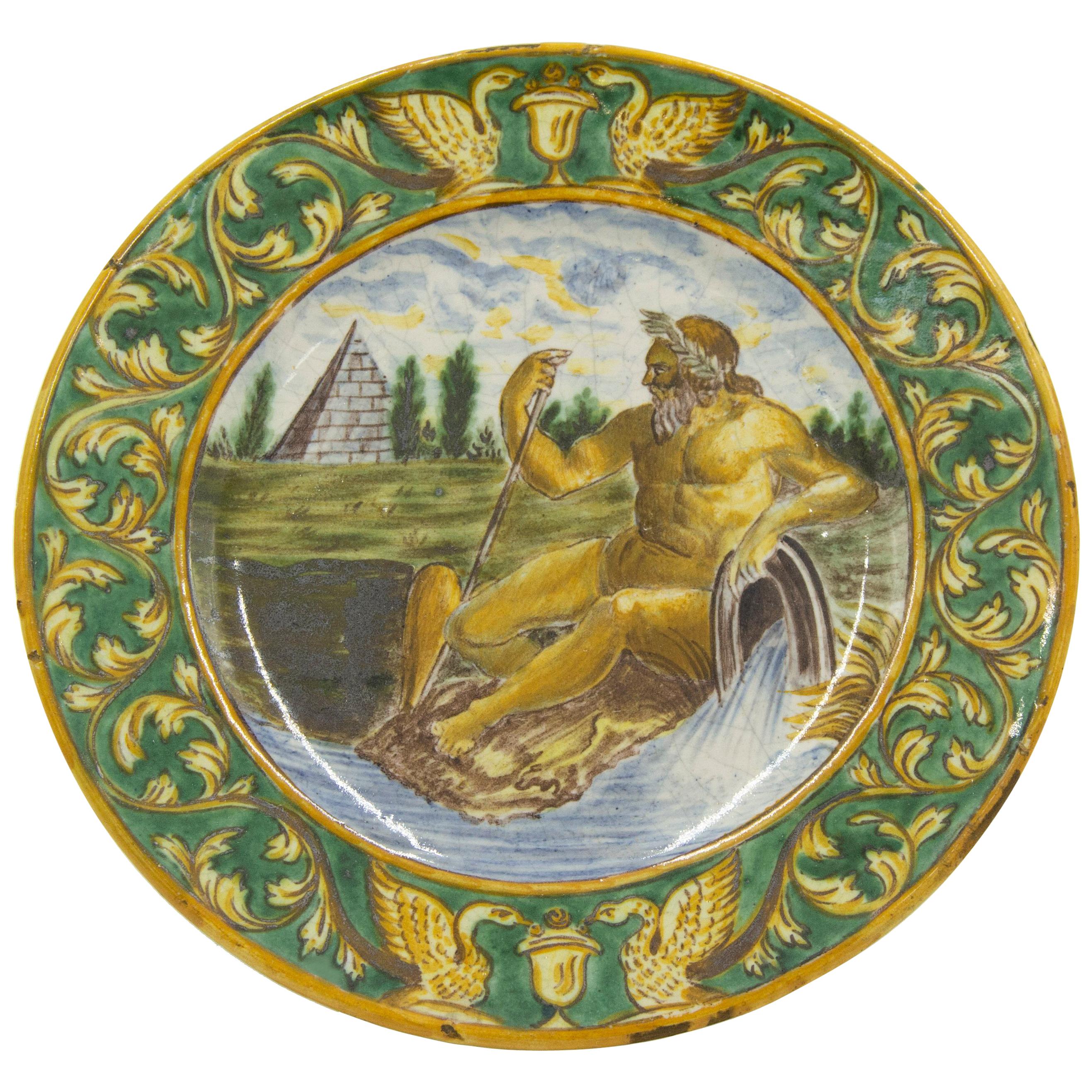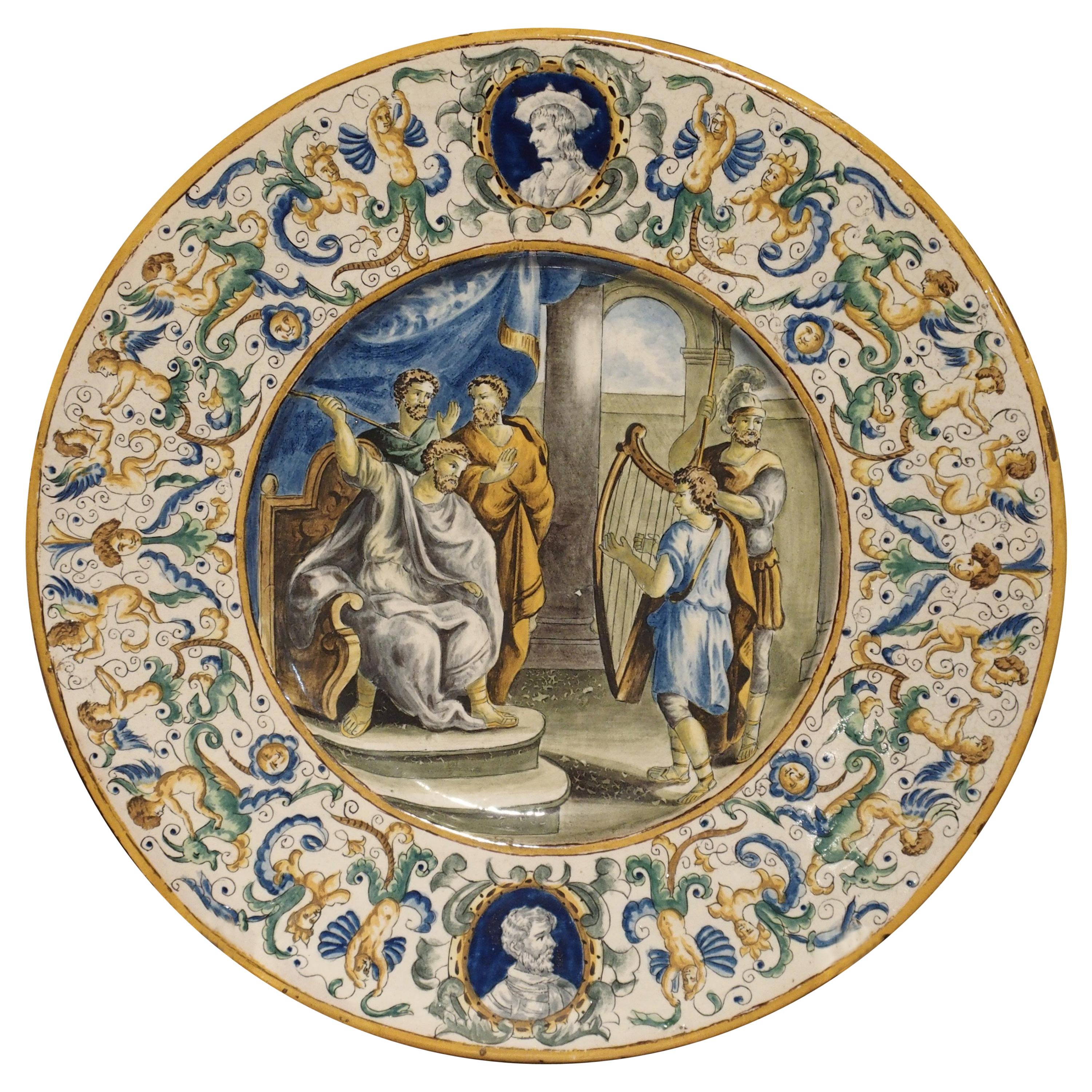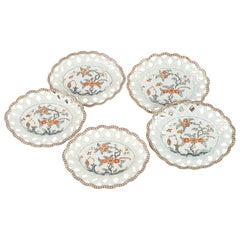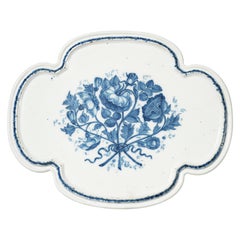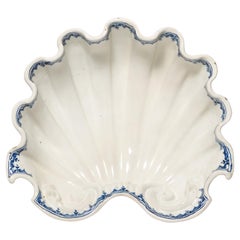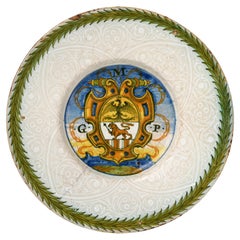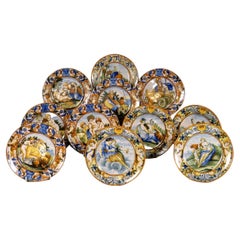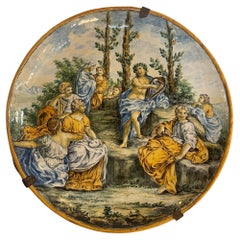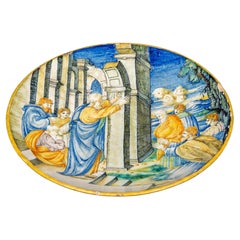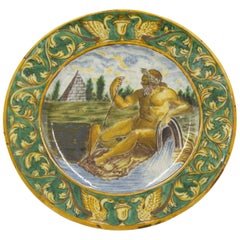Items Similar to Ancient Maiolica Tiles, Ambrogette, Rampini Manufactory, Pavia, 1693-1704
Video Loading
Want more images or videos?
Request additional images or videos from the seller
1 of 19
Ancient Maiolica Tiles, Ambrogette, Rampini Manufactory, Pavia, 1693-1704
$19,163.84per set
£14,201.46per set
€16,000per set
CA$26,162.28per set
A$29,104.46per set
CHF 15,256.92per set
MX$355,649.44per set
NOK 194,277.90per set
SEK 182,885.76per set
DKK 121,822.59per set
Shipping
Retrieving quote...The 1stDibs Promise:
Authenticity Guarantee,
Money-Back Guarantee,
24-Hour Cancellation
About the Item
Six maiolica “ambrogette” (tiles)
Rampini manufactory, painter probably Siro Antonio Africa
Pavia, 1693-1704
a) 6.88 x 5.51 in (17.5 x 14 cm); 0.55 lb (252 g)
b) 7.08 x 5.70 in (18 x 14.5 cm); 0.51 lb (233 g)
c) 6.88 x 5.70 in (17.5 x 14.5 cm); 0.54 lb (245 g)
d) 6.81 x 5.51 in (17.3 x 14 cm); 0.50 lb (230 g)
e) 6.88 x 5.51 in (17.5 x 14 cm); 0.50 lb (229 g)
f) 7.08 x 5.70 in (18 x 14.5 cm); 0.51 lb (233 g)
State of conservation: intact.
These six ”maiolica fina” small “ambrogette” belong to a family of ceramic works considered among the finest produced between the 17th and 18th centuries. For a long time, this type of maiolica was attributed to the Venetian village of Angarano, but later it was definitively attributed to the pottery factories in Pavia. A fundamental study ascribed this production specifically to Pavia through an analysis of Lombard collections and a comparison with archaeological remains found near the two main manufacturing sites in the city. (E. Pelizzoni - M. Forni - S. Nepoti, La maiolica di Pavia tra Seicento e Settecento, Milano 1997).
The six small oval tiles have rounded edges and are decorated with a historiated motif. They were created using high-fired polychrome technique, with a predominance of cool tones and a dominance of gray and blue, interspersed with manganese, citrine yellow, orange-yellow, and green. The six small “ambrogette” are characterized by the same stylistic features, with a similar decorative design.
The first tile (a) depicts a female figure, holding a stiletto and sitting near a pedestal supporting a relief-decorated baluster vase. Behind her, a child is holding a chalice, while through the arches of a portico, a glimpse of a mountainous landscape can be seen in the background. The female figure could possibly be Lucretia, an example of virtue in ancient Roman culture.
In the second “ambrogetta” b), the Biblical episode of Judith and Holofernes is depicted through canonical iconography: the decapitated body of Holofernes lies on the bed in the background, while the protagonist, Judith, is seen placing his head into a sack held by a maidservant. Through an archway a shining slice of the moon gives the perception of nighttime. Surprisingly, within the narrative, there is the presence of a basin in the shape of a large shell, closely resembling the products of Pavia's factories.
The third small plaque (c) depicts a female figure standing on a plinth and framed by an architectural arch with a vast mountainous landscape in the background. The woman, with her breasts exposed, is accompanied by two children: one approaching her as if wanting to be picked up, and the other seated with an apple in his hand. The protagonist lends herself to different interpretations: perhaps she represents Rea Silvia with the two twin founders of Rome, or perhaps she is an allegory for the Pietà, a common theme depicted on maiolica.
In the fourth tile (d), three characters are depicted near a column. The main figure is an old man with a sad expression, holding a cup, while a woman, wearing a turban on her head, also holds a cup in her right hand and a pitcher in her left. A second woman with her hair bound holds another pitcher behind the old man: at his feet a traveller's bag can be seen, along with some apples and a slice of cheese on a rectangular base. It is likely the sad Biblical episode of Lot and his daughters, at the moment when they get him drunk in an effort to restore the human race after the destruction of Sodom.
The last two “ambrogette”, (e) and (f), give more prominence to the landscape, populated by small figures of travellers resting. They are characterized by consistent architectural elements, such as the depiction of an Allegory of Music in the tile (e), or the representation of a horse statue on a pedestal in tile (f). In the latter, a family of wayfarers sits on the left, leaving ample room for a landscape that opens up in perspective, enriched by mountains and distant turreted architecture.
The six tiles were likely part of a decorative series incorporated into wooden supports, possibly a piece of furniture or a frame, or another type of ornamental structure, as described in documents regarding the use of works by "Africa" in Lombard interiors: "six oval maiolica pieces by Africa, also enclosed by carved and gilded wooden frames." (Asp, Notarile di Pavia, G. Re, 13013, 16 agosto 1743).
The use of maiolica tiles as architectural decoration is also demonstrated by the "tiles inserted between stucco volutes to adorn a room in the Palazzo Ghislieri Aizaghi Malaspina, later chiselled out and sold after the death of the last owner, Abbot Spallanzani." (P. Pavesi, L’abate Spallanzani a Pavia, in Memorie della società italiana di scienze naturali e Museo Civico di Storia naturale di Milano, VI-III. Milan 1901, pp. 18-19). The information documents how this significant ceramic production was perceived as early as the 18th century - Lazzaro Spallanzani died in Pavia in 1799 - as being outside of contemporary taste, and subsequently fell into oblivion for more than two centuries.
The pictorial style corresponds to that of the Africa family: it is likely that these works were directly influenced by Siro Antonio Africa, the most refined maiolica painter of the late 17th-century Lombard decorative culture.
The decorator Siro Antonio Africa, along with his nephew Siro Domenico, had worked alternately in the two main Pavia factories (Carlo Giuseppe Rampini and Antonio Francesco Imbres as documented from the last decades of the seventeenth century) where he signed his works in a different way (E. Pelizzoni in, op. cit., pp. 29-32). In the 1735 inventories of the Rampini manufactory, the maiolica were defined with the architecture of Africa. He is considered among the initiators of refined decoration with architecture, of which this work is one of the finest examples. Preserved in the major ceramics museums of the world, the dishes of Pavia are considered among the most elegant works among the eighteenth-century maiolica.
Our oval plaques find particularly close comparisons with the maiolica pieces preserved in some private collections and within the Collection of Applied Arts at the Castello Sforzesco in Milan. (R. Ausenda, a cura di, Musei e Gallerie di Milano. Museo d’Arti Applicate. Le ceramiche, Tomo II, Milan 2001, pp. 101-104, nn. 111-114). A very close comparison in terms of quality and pictorial style can also be made with a centerpiece from the Francesco Franchi collection in the Pinacoteca of Varallo Sesia, depicting a banquet scene with satyrs and bacchantes. (G. Anversa, La collezione Francesco Franchi e la donazione alla Pinacoteca di Varallo Sesia, Borgosesia 2004, p. 302, n. 157).
The pictorial technique of the tiles, where the figures stand out on architectural pedestals juxtaposed with rigorous structures that frame perspective backgrounds and meticulously described landscapes, finds a prestigious comparison in pieces of notable scenic impact, such as the large vase from the D'Azeglio collection at the Civic Museum of Palazzo Madama in Turin. (Pellizzoni, op. cit., p. 173).
This pictorial and stylistic uniformity is also recognizable in the inspiration taken from contemporary engravings: the figures are painted in diluted manganese brown with rounded faces, characterized by small mouths, almost standardized with serious and somewhat melancholic expressions, reminiscent of some engravings based on the drawings of Johann Christoff Storer, who was active in Lombardy during that period. For example, one can observe how the figure of "Purity" by Storer (cod. catalogo nazionale n. 0300619948-7) has been used in tile (c), where the painter reproduces the pose from the engraving, but modifies it in terms of clothing, hairstyle, and, above all, the nature of the character itself, which here represents "Charity."
This approach is found in many characters derived from the well-known engraving by Sole Giovan Dal Gioseffo and Giovanni Paolo Bianchi, with Storer still being the creator. In this engraving, part of the illustrative apparatus for the funeral of Isabella of Spain is depicted, featuring an overall view of the interior of the Cathedral, with allegorical statues representing the virtues of the deceased Queen.
The same approach of freely interpreting engravings can also be seen in the figure of the wayfarer, leisurely reclining in the shade of the columns, in the tile with the Allegory of Music (e). The character here resembles the beggar placed in the foreground in Jacopo Cotta's engraving depicting a triumphal entry (numero catalogo generale: 00636266, Civica Raccolta di Incisioni Serrone Villa Reale), which is also based on a drawing by Storer.
The "ambrogettes" were placed, probably in the 19th century, in 18th-century style carved and gilded wooden frames.
Bibliography:
P. Pavesi, l’abate Spallanzani a Pavia, in Memorie della società italiana di scienze naturali e Museo Civico di Soria naturale di Milano, VI-III. Milano 1901, pp. 18-19;
E. Pelizzoni - M. Forni - S. Nepoti, La maiolica di Pavia tra Seicento e Settecento, Milano 1997;
R. Ausenda, a cura di, Musei e Gallerie di Milano. Museo d’Arti Applicate. Le ceramiche, Tomo II, Milano 2001, pp. 101-104, nn. 111-114.
- Attributed to:Siro Antonio Africa (Painter)
- Dimensions:Height: 7.09 in (18 cm)Width: 5.71 in (14.5 cm)Depth: 0.2 in (5 mm)
- Sold As:Set of 6
- Style:Baroque (Of the Period)
- Materials and Techniques:
- Place of Origin:
- Period:1700-1709
- Date of Manufacture:circa 1700
- Condition:Intact.
- Seller Location:Milano, IT
- Reference Number:1stDibs: LU4352236559352
About the Seller
4.3
Vetted Professional Seller
Every seller passes strict standards for authenticity and reliability
Established in 1860
1stDibs seller since 2018
21 sales on 1stDibs
Associations
International Confederation of Art and Antique Dealers' Associations
- ShippingRetrieving quote...Shipping from: Milano, Italy
- Return Policy
Authenticity Guarantee
In the unlikely event there’s an issue with an item’s authenticity, contact us within 1 year for a full refund. DetailsMoney-Back Guarantee
If your item is not as described, is damaged in transit, or does not arrive, contact us within 7 days for a full refund. Details24-Hour Cancellation
You have a 24-hour grace period in which to reconsider your purchase, with no questions asked.Vetted Professional Sellers
Our world-class sellers must adhere to strict standards for service and quality, maintaining the integrity of our listings.Price-Match Guarantee
If you find that a seller listed the same item for a lower price elsewhere, we’ll match it.Trusted Global Delivery
Our best-in-class carrier network provides specialized shipping options worldwide, including custom delivery.More From This Seller
View AllAncient Maiolica Plates Pasquale Rubati, Milan Circa 1770-1780
By Pasquale Rubati
Located in Milano, IT
Five oval maiolica dishes with pierced edge
Manufacture of Pasquale Rubati
Milan, 1770-1780
Three small oval dishes 10.23 in x 7.67 in (26 cm x 19.5 cm)
Two large oval dishes 10.82 in x 8.85 in (27.5 x 22.5 cm)
lb 3.5 (kg 1.8)
State of conservation: intact
The five dishes of different sizes have an oval shape, a mixtilinear edge and a molded polylobed shape with a surface enriched with a relief weave motif extending to the brim and forming a perforated basket...
Category
Antique 1770s Italian Rococo Ceramics
Materials
Maiolica
18th Century Italian Maiolica Centerpiece Bassano Venice, circa 1750
Located in Milano, IT
Maiolica centerpiece
Pasquale Antonibon factory
Nove di Bassano, Venice, 1740-1770.
Measures: 1.85 in x 19.21 in x 15.27 in
4.7 cm X 48.8 cm X 38.8 cm.
lb 5.29 (kg 2.4)
State of conservation: thin passing fêlure with covered chipping and a glued foot
The Antonibon were an important family of Venetian...
Category
Antique 1750s Italian Baroque Ceramics
Materials
Maiolica
Ancient Italian Maiolica Faenza, Ferniani Factory, Circa 1700
By Ferniani Factory
Located in Milano, IT
Centerpiece white maiolica shell
Ferniani factory, early period: 1693-1776
Faenza, circa 1700
Measures: 5.6 in x 14.72 in x 13.46 in (14.3 cm x 37.4...
Category
Antique Early 1700s Italian Baroque Ceramics
Materials
Maiolica
Small Maiolica Plate, Urbino District, 1533-1555
Located in Milano, IT
Maiolica plate (tondino)
Urbino district, Casteldurante or Pesaro, 1533-1555
It measures: diam. 7.48 in (19 cm), foot diam. 2.75 in (7 cm), height 1.0...
Category
Antique 16th Century Italian Renaissance Ceramics
Materials
Maiolica
Italian Renaissance Plate, Patanazzi Workshop Urbino, End of 16th Century
By Patanazzi Workshop
Located in Milano, IT
Acquareccia plate
Patanazzi workshop
Urbino, last quarter of the 16th century
It measures diameter 17.12 in; foot diameter 11.53 in; height 1.88 in (43.5 cm; 29.3 cm; 4.8 cm).
Weight
State of conservation: wear and a few small minimal detachments of enamel, chipping on the raised areas, peeling of enamel at the brim on the back.
This large, shallow basin is equipped with a wide and convex well. It is umbonate with a contoured center. The brim, short and flat, is enclosed in a double rounded and barely raised edge. The basin has a flat base without rims; it has a slightly concave center in correspondence to the well.
The shape takes inspiration from the basins associated with the metal forged amphora pourers that traditionally adorned the credenza. These were used from the Middle Ages to wash hands during banquets. Two or three people washed their hands in the same basin and it was considered an honor to wash one’s hands with an illustrious person.
The decoration is arranged in concentric bands with, in the center of the umbo, an unidentified shield on a blue background: an oval banded in gold with a blue head, a gold star and a field with a burning pitcher.
Rings of faux pods separate the center from a series of grotesque motifs of small birds and masks. These go around the basin and are, in fact, faithfully repeated on the brim. The main decoration develops inside the flounce of the basin, which sees alternating symmetrical figures of winged harpies and chimeras. The ornamentation, outlined in orange, green and blue, stands out against the white enamel background.
This decorative style, defined since the Renaissance as “grottesche” or “raffaellesche”, refers to the decorations introduced after the discovery of the paintings of the Domus Aurea towards the end of the fifteenth century. The discovery of Nero's palace, buried inside Colle Oppio by damnatio memoriae, occurred by chance when a young Roman, in 1480, fell into a large crack which had opened in the ground on the hill, thus finding himself in a cave with walls covered with painted figures.
The great artists present in the papal city, including Pinturicchio, Ghirlandaio, Raffaello, immediately visited these caves. The decorations found there soon became a decorative subject of immense success: the term grotesque , with the meaning of “unusual,” “caricatured,” or “monstrous,” was later commented by Vasari in 1550 as “una spezie di pittura licenziose e ridicole molto”( “a very licentious and ridiculous kind of painting”).
The decorations “a grottesche” also widely circulated in ceramic factories, through the use of engravings, variously interpreted according to the creativity of the artists or the requests of the client.
Our basin is reflected in similar artifacts produced at the end of the sixteenth century by the factories of the Urbino district. See the series of basins preserved in the main French museums, among which the closest in morphology is that of the Campana collection of the Louvre (Inv. OA1496); this however has a more complex figure decoration, while the decoration of our specimen is sober and with a watercolor style.
The style, sure in its execution, approaches decorative results still close to the works produced around the middle of the sixteenth century by the Fontana workshop. The decoration is closely linked to their taste, which later finds its natural outlet, through the work of Antonio, also in the Patanazzi workshop. Studies show the contiguity between the two workshops due to the kinship and collaboration between the masters Orazio Fontana and Antonio Patanazzi, both trained in the workshop of Guido Fontana il Durantino. It is therefore almost natural that their works, often created according to similar typologies and under the aegis of the same commissions, are not always easily distinguishable, so much so that the presence of historiated or “grottesche” works by Orazio is documented and preserved in Antonio Patanazzi's workshop. Given that the studies have always emphasized the collaboration between several hands in the context of the shops, it is known that the most ancient “grottesche” works thus far known, can be dated from 1560, when the Fontana shop created the so-called Servizio Spagnolo (Spanish Service) and how, from that moment on, this ornamentation became one of the most requested by high-ranking clients. We remember the works created for the Granduchi di Toscana, when Flaminio Fontana along with his uncle Orazio supplied ceramics to Florence, and, later, other commissions of considerable importance: those for the service of the Duchi d’Este or for the Messina Farmacia of Roccavaldina, associated with the Patanazzi workshop when, now after 1580, Antonio Patanazzi began to sign his own work.
Thus, in our basin, the presence of masks hanging from garlands, a theme of more ancient memory, is associated in the work with more advanced stylistic motifs, such as the hatching of the chimeras and harpies. These are found here on the front with the wings painted in two ornate ways. In addition, the theme of the birds on the edge completes the decoration along the thin brim and can be seen as representing an early style typical of the Urbino district during a period of activity and collaboration between the two workshops. Later, a more “doll-like” decorative choice, typical of the end of the century and the beginning of the seventeenth century, characterized the period of the Patanazzi workshop under the direction of Francesco.
Bibliography:
Philippe Morel, Il funzionamento simbolico e la critica delle grottesche nella seconda metà del Cinquecento, in: Marcello Fagiolo, (a cura di), Roma e...
Category
Antique 16th Century Italian Renaissance Ceramics
Materials
Maiolica
Ancient Maiolica Dishes with flowers, Lombard Manufacture, 1770-1780 Circa
Located in Milano, IT
Assortment of dishes
Lombard manufacture
1770 – 1780 Circa
Maiolica polychrome decorated “a piccolo fuoco” (third fire).
Two large dishes: diameter 14.76 in (37.5 cm); weight 4.5...
Category
Antique 1770s Italian Rococo Ceramics
Materials
Maiolica
You May Also Like
Set of Eleven Hand Decorated Italian Majolica Cabinet Plates, Circa 1920
Located in Ottawa, Ontario
All eleven of these very charming cabinet plates having crazed bodies with hand painted mythological & romantic vignettes, surrounded by borders decorated with foliate designs interspersed with cherubs & masks.
All signed with artists monogram CM...
Category
Early 20th Century Italian Neoclassical Revival Pottery
Materials
Majolica
19th Century Italian Majolica Charger
Located in Los Angeles, CA
19th Century Italian Majolica charger with hand painted scenery in great detail.
Dimensions:
2"H x 16"D
Category
Antique 19th Century Italian Dinner Plates
Materials
Porcelain
Beautiful Tuscan Ceramic Plate 17th Century
Located in Madrid, ES
Beautiful Tuscan Ceramic Plate 17th Century
with a deepened centre, painted with a biblical scene, landscape and architecture, glazed on the underside, described and marked.
Diamete...
Category
Antique 17th Century Italian Baroque Decorative Art
Materials
Porcelain
Set of 6 Renaissance Style Majolica Porcelain Plates
Located in Queens, NY
Set of 6 Italian Renaissance-style (17/18th Century) green and gold Majolica porcelain plates with classical scenes (Sara D. Roosevelt) (PRICED AS SET)
Category
Antique 18th Century Italian Renaissance Dinner Plates
Materials
Porcelain
19th Century Hand Painted Majolica Platter from Italy
Located in Dallas, TX
From Italy, this hand painted Majolica platter has two areas of ornamentation. The outer circle has busts of two different men, one on the top of the platter and one at the bottom. T...
Category
Antique 19th Century Italian Delft and Faience
Materials
Majolica
Large Italian Majolica Charger by Sandro Angelini
Located in Kilmarnock, VA
A remarkable large neoclassical charger crafted by the multifaceted Italian architect and artist Sandro Angelini. A distinguished student of the legendary Gio Ponti and a close frien...
Category
Mid-20th Century Italian Neoclassical Revival Ceramics
Materials
Ceramic
